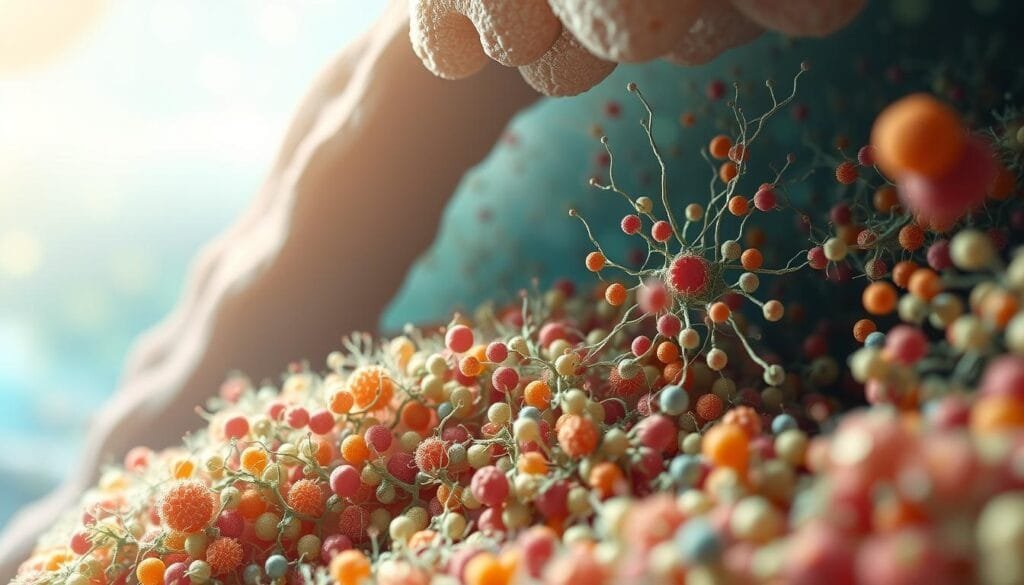Currently Empty: RM0.00
Your mouth isn’t just for smiling—it’s a thriving ecosystem. Over 1,000 types of bacteria coexist here, with populations reaching hundreds of millions in every drop of saliva. This delicate balance between helpful and harmful microbes directly impacts not just dental wellness, but your entire body’s health.
Wellness Concept brings clarity to this microscopic world. As trusted advisors in natural care solutions, we explore how specific beneficial bacteria—probiotics—support oral balance. Recent studies reveal these live microorganisms may outperform traditional antimicrobial methods by fostering harmony rather than destruction.
The mouth-body connection makes this topic vital. An unbalanced oral microbiome can affect digestion, immunity, and even heart health. Emerging science shows targeted probiotics might help address common concerns like plaque buildup and gum irritation while promoting systemic wellness.
Key Takeaways
- The mouth contains a complex bacterial ecosystem influencing overall health
- Probiotics offer a natural approach to maintaining oral balance
- Wellness Concept provides evidence-based guidance on microbial health
- Oral probiotics may complement traditional dental care methods
- Research shows connections between mouth bacteria and body-wide systems
Introduction to Probiotics and Oral Health
Inside every mouth, tiny allies work tirelessly to maintain harmony. These beneficial microorganisms form the frontline defense against imbalances affecting both dental and general health. Understanding their function opens new possibilities for natural care strategies.
Definition and Overview of Probiotics
Probiotics are live strains of bacteria that strengthen biological systems when consumed adequately. Unlike harsh antimicrobial products that wipe out all microbes, these friendly strains compete with harmful bacteria for space and resources. This approach supports the mouth’s natural equilibrium without disrupting essential functions.
Importance of Oral Health in Overall Wellbeing
Gum inflammation and tooth decay often signal deeper systemic issues. Research links poor oral conditions to cardiovascular challenges and blood sugar irregularities. Maintaining a balanced oral environment acts as preventive medicine for the entire body.
Modern lifestyles—like sugary diets and stress—disrupt microbial harmony. Integrating probiotic-rich foods or supplements offers a practical solution. For those exploring the health benefits of probiotics, targeted strains show particular promise in supporting both local and whole-body wellness.
Understanding the Oral Microbiota
Imagine a bustling city thriving in your mouth—home to over 700 bacterial species. These microorganisms form intricate communities across the tongue, teeth, and gums. Like skilled neighbors, beneficial strains protect their territory while keeping harmful invaders in check.

The Balance Between Good and Harmful Bacteria
Your oral cavity operates like a biological seesaw. Friendly bacteria produce enzymes that break down food particles and neutralize acids. Harmful strains, however, multiply when sugar intake rises or brushing habits slip. This tug-of-war determines whether your mouth stays healthy or develops issues.
Scientists describe this dynamic through ecological plaque theory. Bacterial populations don’t act alone—they form alliances or compete for resources. A sugary snack might fuel acid-producing microbes, tipping the balance toward enamel erosion. Stress or antibiotics can further disrupt this fragile ecosystem.
Different mouth zones host specialized communities. The tongue’s grooves shelter oxygen-loving species, while gum crevices harbor bacteria adapted to low-oxygen environments. Each area requires distinct care strategies to maintain equilibrium.
Daily choices directly influence this microbial metropolis. Crunchy vegetables scrub surfaces naturally, while sticky sweets feed destructive strains. Even hydration matters—dry mouths struggle to control bacterial overgrowth. Recognizing these factors empowers smarter decisions for lasting oral harmony.
What is the role of probiotics in oral health?
Think of your mouth as a microscopic battlefield where friendly forces protect their territory. Specific probiotic strains deploy smart strategies to maintain harmony in the oral cavity. They don’t just occupy space—they actively reshape microbial communities through biological teamwork.
Nature’s Defense System
Good bacteria compete for prime real estate on tooth surfaces and gums. This colonization resistance prevents harmful microbes from settling. Like skilled negotiators, they also release natural substances that dissolve plaque biofilms.
| Mechanism | Action | Benefit |
|---|---|---|
| Space Competition | Blocks adhesion sites | Reduces plaque buildup |
| Acid Production | Lowers pH balance | Prevents enamel erosion |
| Immune Signaling | Calms inflammation | Supports gum health |
These microbial allies produce hydrogen peroxide and bacteriocins—natural compounds that target troublemakers without harming beneficial species. Studies show certain probiotic strains can reduce cavity-causing bacteria by 50% within weeks.
The oral cavity benefits doubly from these actions. Direct microbial competition pairs with immune system modulation. This dual approach helps maintain balanced bacteria levels while supporting the body’s natural defense networks.
Scientific Evidence and Clinical Studies
Cutting-edge research now maps how beneficial bacteria wage microscopic wars for dental wellness. Over 40 clinical studies reveal measurable improvements when specific strains join daily routines. These findings transform theoretical concepts into actionable health strategies.

Key Research Findings
A 2021 trial by Duraisamy’s team showed 58% reduction in cavity-causing bacteria within two weeks of probiotic use. Patients using lozenges with Lactobacillus reuteri experienced fewer plaque deposits compared to control groups.
Meta-analyses pooling data from 1,200 participants confirm:
- 33% decrease in gum bleeding scores
- 1.5mm average reduction in periodontal pocket depth
- Improved breath freshness lasting 6+ hours
Impact on Dental Caries and Periodontal Disease
Randomized trials demonstrate probiotics’ dual action. They disrupt harmful biofilm formation while calming inflamed gum tissues. Children receiving probiotic milk products showed 44% fewer cavities over three years.
| Study Focus | Patient Group | Key Effect |
|---|---|---|
| Gingivitis | Adults | 31% less inflammation |
| Caries Prevention | Children | 2.3x lower decay risk |
| Periodontitis | Seniors | Improved chewing ability |
While effects vary by delivery method, dissolving tablets show strongest adherence to oral surfaces. Research continues to optimize strains and dosing for lasting treatment benefits.
Exploring Mechanisms of Probiotic Action
Beneath the surface of every smile lies a complex biological network where friendly microbes deploy sophisticated strategies. These microscopic guardians use chemical warfare and cellular diplomacy to maintain oral equilibrium.
Direct Interactions and Colonization Resistance
Beneficial bacteria act like skilled architects, reshaping their environment. They release organic acids and bacteriocins—natural compounds that inhibit harmful microbial growth. This creates zones where destructive strains struggle to survive.
Colonization resistance works through simple rules:
- Occupying prime adhesion sites on teeth and gums
- Consuming nutrients competitors need
- Creating biofilms that block invaders
Lactic acid production lowers pH levels, making conditions unfavorable for acid-sensitive pathogens. Hydrogen peroxide acts as a natural disinfectant without damaging delicate tissues.
Immunomodulatory Effects
Probiotic strains engage in molecular conversations with immune cells. They stimulate macrophages to patrol more effectively while calming excessive inflammatory responses. This balance helps prevent gum tissue damage during infections.
Key immune interactions include:
- Upregulating protective mucin production
- Enhancing epithelial cell regeneration
- Modulating cytokine release patterns
These effects create a protective shield that adapts to threats. Research shows certain strains can increase defensive peptides by 40%, strengthening the mouth’s first line of defense.
Long-Term Effects and Considerations of Probiotic Therapy
Maintaining oral health through probiotics isn’t a quick fix—it’s a marathon, not a sprint. While these beneficial bacteria show promise, their effects often fade when treatment stops. Research reveals a key insight: consistent use matters more than occasional doses.
Study Outcomes on Probiotic Persistence
Clinical trials paint a clear picture. When participants stopped probiotic therapy, harmful bacteria like P. gingivalis rebounded within four weeks. Yet some benefits lingered—one study noted reduced anaerobic microbes for up to five months before levels normalized.
| Time After Stopping | Observed Change | Key Insight |
|---|---|---|
| 4 weeks | Pathogen resurgence | Quick rebound without support |
| 21 weeks | Partial benefits maintained | Delayed regression |
| 1 year | Baseline restoration | No permanent colonization |
Three factors determine how long benefits last:
- Strain selection: Native oral bacteria stick better
- Delivery method: Lozenges outperform capsules
- Host biology: Unique microbiome responses
For lasting results, combine probiotics with brushing and low-sugar diets. Emerging strains designed for oral adhesion may soon extend long term benefits. Until then, think of these microbes as temporary residents needing regular invitations to stay.
Comparison of Probiotic Strains for Oral Health
Choosing the right microbial allies requires understanding their specialties. Like precision tools, different strains target specific oral challenges through unique biological mechanisms.
Notable Microbial Specialists
Lactobacillus reuteri shines in gum health. Clinical trials show this probiotic strain reduces periodontal pathogens by 67% while improving pocket depth measurements. It produces reuterin—a natural compound that suppresses harmful bacteria without disrupting beneficial flora.
For fresh breath concerns, Weissella cibaria offers targeted action. This strain neutralizes volatile sulfur compounds by:
- Competing with odor-producing bacteria
- Breaking down cysteine substrates
- Maintaining optimal pH levels
| Strain | Key Action | Clinical Benefit |
|---|---|---|
| Bifidobacterium HN019 | Enhances immune response | 43% faster gum healing |
| L. salivarius | Inhibits S. mutans | 38% fewer cavities |
| W. cibaria | Reduces sulfur gases | 81% fresher breath |
Bifidobacterium strains work systemically. HN019 boosts IgA antibodies in saliva, strengthening defenses against oral infections. When combined with scaling treatments, it improves clinical outcomes by 29% compared to procedures alone.
For comprehensive care, multi-strain formulas create synergistic effects. Pairing Lactobacillus species with Bifidobacterium enhances both localized protection and whole-mouth balance. Always match strains to individual needs—gum health requires different allies than cavity prevention.
Integrating Probiotics into Daily Oral Hygiene
Maintaining a healthy smile goes beyond brushing—strategic probiotic use can enhance daily care. Simple swaps and timed habits help beneficial bacteria thrive while supporting traditional oral hygiene practices.
Supplement Options and Food Sources
Slow-dissolving lozenges work best for coating teeth and gums. Chewable tablets offer convenience, while probiotic yogurts add microbial diversity through diet. Studies show formulas containing L. reuteri or Bifidobacterium strains deliver measurable improvements.
For optimal results:
• Use lozenges after evening brushing
• Pair probiotic tablets with breakfast
• Include fermented foods like kimchi or kefir
Routine Practices for a Healthy Oral Microbiota
Timing matters—taking probiotics before bedtime maximizes their contact time with the mouth. Avoid rinsing immediately after use to let beneficial strains adhere. Combine with fluoride toothpaste and interdental cleaning for comprehensive oral hygiene.
Consistency beats intensity. Daily probiotic use over weeks yields better microbial balance than sporadic high doses. Track changes in gum sensitivity or breath freshness to gauge effectiveness.
FAQ
How do probiotics support a healthy oral cavity?
Probiotics help balance bacteria in the mouth by crowding out harmful strains. They produce substances like lactic acid to inhibit pathogens linked to cavities or gum issues. Certain strains, such as Lactobacillus, also strengthen the oral microbiome’s defenses.
Can probiotics reduce bad breath effectively?
Studies suggest probiotics like Weissella cibaria may lower volatile sulfur compounds, a primary cause of halitosis. Regular use of lozenges or probiotic-rich foods could lead to fresher breath, though results vary based on individual oral hygiene habits.
Are oral probiotics safe for long-term use?
Most clinical trials show minimal side effects when using strains like Bifidobacterium or Lactobacillus for oral health. However, consulting a dentist ensures compatibility with existing treatments, especially for those with compromised immune systems.
Which probiotic strains target gum disease?
Research highlights Lactobacillus reuteri and Weissella cibaria for reducing gingivitis inflammation. These strains compete with plaque-forming bacteria and may lower bleeding gums when paired with brushing and flossing.
Do probiotic yogurts benefit teeth like supplements?
Fermented dairy products contain live cultures that support oral health, but their effects are milder compared to targeted probiotic tablets or mouthwashes. For significant benefits, opt for products specifically designed for the mouth, like probiotic lozenges.
How quickly do oral probiotics work?
Some users notice improvements in breath or gum sensitivity within 1–2 weeks. Clinical trials often measure changes, like reduced plaque, after 4–8 weeks of consistent use. Long-term therapy tends to yield more stable results.


